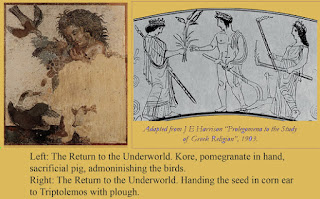
Of Myth and Science: The Thirteenth Piglet. The prehistoric site of the Tarxien Megalithic Temple is one of a number of sites in the Maltese Islands that hosts megalithic structures. But it is also one that has ancient carvings in relief. One such relief that is the subject of this piece, is one that shows a sow with thirteen suckling piglets. The megalithic structures that functioned as solar calendars, and the related agrarian lore related to cereals, - the Two Queens, - were both centred on fertility and abundance. However in Tarxien temple there is also featured animal husbandry, where the 'sow with piglets' relief appears to be symbolic of natural fecundity. The meaning is hidden in the detail. Recent modern selective breeding in pigs aims particularly for sows with 12 to 14 functional teats as a high standard. However the ancient pig breeder long ago knew that 12 functional teats was a high ideal. He also knew that each piglet at birth selected a teat from ...




